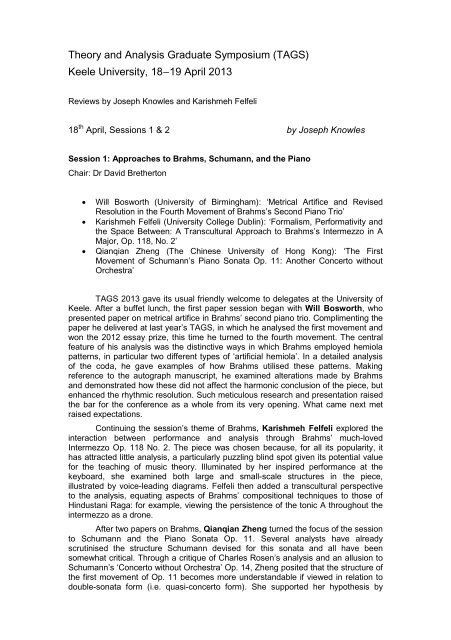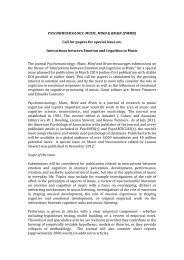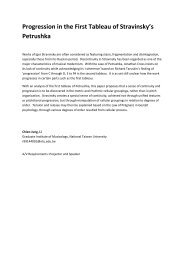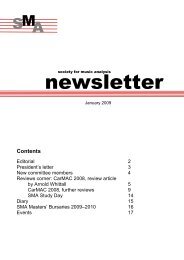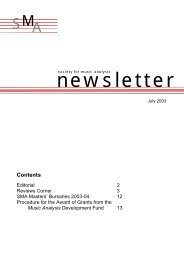Review - Society for Music Analysis
Review - Society for Music Analysis
Review - Society for Music Analysis
You also want an ePaper? Increase the reach of your titles
YUMPU automatically turns print PDFs into web optimized ePapers that Google loves.
Theory and <strong>Analysis</strong> Graduate Symposium (TAGS)<br />
Keele University, 18–19 April 2013<br />
<strong>Review</strong>s by Joseph Knowles and Karishmeh Felfeli<br />
18 th April, Sessions 1 & 2 by Joseph Knowles<br />
Session 1: Approaches to Brahms, Schumann, and the Piano<br />
Chair: Dr David Bretherton<br />
<br />
<br />
<br />
Will Bosworth (University of Birmingham): ‘Metrical Artifice and Revised<br />
Resolution in the Fourth Movement of Brahms’s Second Piano Trio’<br />
Karishmeh Felfeli (University College Dublin): ‘Formalism, Per<strong>for</strong>mativity and<br />
the Space Between: A Transcultural Approach to Brahms’s Intermezzo in A<br />
Major, Op. 118, No. 2’<br />
Qianqian Zheng (The Chinese University of Hong Kong): ‘The First<br />
Movement of Schumann’s Piano Sonata Op. 11: Another Concerto without<br />
Orchestra’<br />
TAGS 2013 gave its usual friendly welcome to delegates at the University of<br />
Keele. After a buffet lunch, the first paper session began with Will Bosworth, who<br />
presented paper on metrical artifice in Brahms’ second piano trio. Complimenting the<br />
paper he delivered at last year’s TAGS, in which he analysed the first movement and<br />
won the 2012 essay prize, this time he turned to the fourth movement. The central<br />
feature of his analysis was the distinctive ways in which Brahms employed hemiola<br />
patterns, in particular two different types of ‘artificial hemiola’. In a detailed analysis<br />
of the coda, he gave examples of how Brahms utilised these patterns. Making<br />
reference to the autograph manuscript, he examined alterations made by Brahms<br />
and demonstrated how these did not affect the harmonic conclusion of the piece, but<br />
enhanced the rhythmic resolution. Such meticulous research and presentation raised<br />
the bar <strong>for</strong> the conference as a whole from its very opening. What came next met<br />
raised expectations.<br />
Continuing the session’s theme of Brahms, Karishmeh Felfeli explored the<br />
interaction between per<strong>for</strong>mance and analysis through Brahms’ much-loved<br />
Intermezzo Op. 118 No. 2. The piece was chosen because, <strong>for</strong> all its popularity, it<br />
has attracted little analysis, a particularly puzzling blind spot given its potential value<br />
<strong>for</strong> the teaching of music theory. Illuminated by her inspired per<strong>for</strong>mance at the<br />
keyboard, she examined both large and small-scale structures in the piece,<br />
illustrated by voice-leading diagrams. Felfeli then added a transcultural perspective<br />
to the analysis, equating aspects of Brahms’ compositional techniques to those of<br />
Hindustani Raga: <strong>for</strong> example, viewing the persistence of the tonic A throughout the<br />
intermezzo as a drone.<br />
After two papers on Brahms, Qianqian Zheng turned the focus of the session<br />
to Schumann and the Piano Sonata Op. 11. Several analysts have already<br />
scrutinised the structure Schumann devised <strong>for</strong> this sonata and all have been<br />
somewhat critical. Through a critique of Charles Rosen’s analysis and an allusion to<br />
Schumann’s ‘Concerto without Orchestra’ Op. 14, Zheng posited that the structure of<br />
the first movement of Op. 11 becomes more understandable if viewed in relation to<br />
double-sonata <strong>for</strong>m (i.e. quasi-concerto <strong>for</strong>m). She supported her hypothesis by
giving examples of how themes from the first exposition were reused throughout the<br />
movement and then the sonata as a whole. All three papers sparked fruitful<br />
discussions that continued into the following coffee break.<br />
Session 2: Analysing <strong>Music</strong> in Transition<br />
Chair: Dr Kenneth Smith<br />
Daniel Holden (University of Leeds): Varying the Variant: Motivic Processes<br />
in the Finale of Mahler’s Sixth Symphony’<br />
Frederick Reece (Harvard University): ‘Hugo Wolf’s Harmony as<br />
Weitzmannian Critique: The Augmented Triad and its Hexatonic Shadows’<br />
Miona Dimitrijevic (University of Strasbourg): ‘The Formal <strong>Analysis</strong> of Max<br />
Reger’s Orchestral Works’<br />
Martin Curda (Cardiff University): ‘In Search of Modern Moravian <strong>Music</strong>:<br />
Tradition and Innovation in the String Quartets of Janáček’s Students from<br />
the 1920s’<br />
Fortified by refreshments, the delegates reconvened <strong>for</strong> the second session,<br />
which opened with Daniel Holden’s paper on motivic processes in the finale of<br />
Mahler’s sixth symphony. Taking Theodor Adorno’s premise of Mahler’s ‘variant<br />
technique’ (constantly trans<strong>for</strong>ming motifs) as his starting point, Holden set out to<br />
show that there are more categories of motivic development in Mahler’s<br />
compositional process. He demonstrated through vividly animated audio-visual<br />
diagrams the development of individual musical segments. We gained a real sense<br />
of how Mahler used motivic ideas and patterns, not only through variation, but also<br />
by restatement, development and re-derivation. Furthermore, Holden’s presentation<br />
revealed how these many motifs were ultimately derived from two basic ones.<br />
Frederick Reece (Harvard University) explored the harmonic language of Hugo Wolf<br />
in two Lieder: Abschied and Das Ständchen. He began with Wolf’s structural<br />
harmonic use of the augmented triad, explained through a combination of insights<br />
from the nineteenth-century German theorist Carl Friedrich Weitzmann and presentday<br />
perspectives largely indebted to Richard Cohn. Expanding the Weitzmannian<br />
model after Cohn, Reece demonstrated how these augmented triads could become<br />
hexachordal structures and then showed how Wolf applied these in his modulations<br />
and the harmonic structure of the two Lieder.<br />
The final paper of the day, presented by Martin Curda, examined a dilemma that<br />
faced students of Janáček in the 1920s: namely their desire to preserve and develop<br />
his legacy whilst finding a compositional voice independent of his. More specifically,<br />
he looked into how Vilém Petrželka, Václav Kaprál and Pavel Haas dealt with this<br />
dilemma against the backdrop of an awareness of Moravian musical tradition in the<br />
newly established Czechoslovakia. Through selected excerpts from string quartets<br />
and by referring to small and large-scale structures, diversity of tempi, textures and<br />
stylistic emulation, Curda compared these Janáček pupils not only to their renowned<br />
teacher, but also to each other.<br />
Editor’s note: The keynote address is reviewed towards the end.
19 th April, Sessions 3 & 4 by Karishmeh Felfeli<br />
Our noblest impulse, to know and understand, makes it our duty<br />
to search. Even a false theory, if found through genuine<br />
searching, is superior to the complacent certainty of those who<br />
presume to know—to know, although they themselves have<br />
never searched.<br />
Arnold Schoenberg, Theory of Harmony, trans. Roy E. Carter (Berkeley:<br />
University of Cali<strong>for</strong>nia Press, 2010), p. 8.<br />
Despite the remarkable diversity expressed by all seven papers that were<br />
presented in the third and fourth sessions of TAGS 2013, there was a commonality of<br />
purpose, in that all the fascinating analytical insights provided by the participants<br />
were not merely intended as an end in itself, but were clearly the by-products of<br />
genuine searching. What is more, I was struck by how easily and ef<strong>for</strong>tlessly<br />
participants were able to present their work in a way that reconciled Schoenbergian<br />
oppositions between 'style' and 'idea'.<br />
Session 3 – Bodies and embodiments<br />
Chair: Dr Shay Loya<br />
<br />
<br />
<br />
Lara Pearson (Durham University): ‘Coarticulation and Kinetic Analogy in<br />
South Indian music’<br />
Vivien Leanne Saunders (Lancaster University): ‘Full House of Usher:<br />
Per<strong>for</strong>ming the Gothic in Usher’s Waltz’<br />
Steve Tromans (Middlesex University): ‘From Body to Body, on the Hither<br />
Side of Words or Concepts: Transferability in, and following, an Artistic<br />
Experiment in Practice-as-Research’<br />
Session three opened with Lara Pearson's exploration of movement in her<br />
recording of Raga Todi's unmetered alapana, per<strong>for</strong>med by violinist T.K.V.<br />
Ramanujacharlu. Moving between the linguistic theory of coarticulation and the<br />
musical theories of 'kinetic anaphones', Pearson demonstrated the way in which the<br />
per<strong>for</strong>mer is able to conceive of gamakas or ornaments as being made up of smaller,<br />
discrete units that ultimately merge with surrounding sound events when realised in<br />
per<strong>for</strong>mance. Pearson was able to highlight the value of a musical-analytical<br />
approach that is in constant dialogue with the creative acts of composition and<br />
per<strong>for</strong>mance as they apply to Karnatak music.<br />
Next, Vivien Leanne Saunders adopted a case-study approach with the<br />
purpose of identifying manifestations of the Gothic both in music and text by<br />
engaging with the ineffable as it applied to her comparative analysis of Edgar Allan<br />
Poe's The Fall of the House of Usher (1839) and Nikita Koshkin's Usher Valse <strong>for</strong><br />
Solo Guitar (1984). Despite its high quirkiness quotient, this paper presented a<br />
serious argument <strong>for</strong> a per<strong>for</strong>mative analysis that remains sensitive to the meaninggenerative<br />
potential contained within each work, while also taking into account the<br />
concepts and contexts that help define it.
The themes of timelessness and ineffability continued to provide an<br />
unconventional but fitting introduction to the final paper of this session in which Steve<br />
Tromans, himself an accomplished jazz pianist, moved easily between the<br />
confessional and more objective modes of presentation. Drawing on a wide range of<br />
sociological theoretical frameworks, Tromans sought to make sense of the temporal<br />
complexities inherent in the music-making process. Personal anecdotes and<br />
demonstrations at the piano served to <strong>for</strong>eground how the academic discourse<br />
generated by such a per<strong>for</strong>mative investigation can be communicated to music<br />
practitioners.<br />
Session 4 – New <strong>Music</strong> and New Approaches<br />
Chair: Dr Helen Thomas<br />
<br />
<br />
<br />
<br />
René Mogensen (Birmingham Conservatoire/Birmingham City University):<br />
‘Identifying Types of <strong>Music</strong>ian-Computer Interactivity in Score-Based Concert<br />
Works’<br />
Joseph Knowles (University of York): ‘The Implications of Set-Theory<br />
<strong>Analysis</strong> on the <strong>Music</strong> of Gesualdo’<br />
Jun Zubillaga-Pow (King’s College London): ‘Taking Chances: Schoenberg’s<br />
Fourth String Quartet and Aleatoric <strong>Analysis</strong>’<br />
Christopher Hayne (University of Surrey): ‘Structural Depth and Melodic<br />
Chains: Jonathan Harvey’s Madonna of Winter and Spring’<br />
The final session of TAGS 2013 brought together four very different<br />
perspectives on the music compositional process, by way of an extraordinarily rich<br />
selection of case-study works spanning six hundred years. René Mogensen strove<br />
to provide a typology of interactivity that was focused on musicians and electronic<br />
systems in live per<strong>for</strong>mance situations. Drawing from a variety of socioeconomic<br />
models, Mogensen first identified interactivity types that could be adequately<br />
described and analysed using the diagrammatic 'interaction interface', be<strong>for</strong>e<br />
investigating the data flow system of the musical work. Although the elaborate charts<br />
were occasionally difficult to absorb, this thorough investigation made <strong>for</strong> a rich<br />
presentation.<br />
Next, Joseph Knowles sought to examine the implications of set-theory<br />
analysis on Gesualdo's moving harmonies, in which modally conceived structures<br />
exist alongside passages of striking chromaticism, producing music that resists<br />
categorical fixity due to its inherent hybridity. Using Gesualdo's madrigal Mercè grido<br />
piangendo (Mercy, I cry, weeping) as an extended analytical example, Knowles was<br />
able to make sense of the composer's procedures through a pitch-class-set analysis<br />
that demonstrated an awareness of socio-historical contexts as well as a keen<br />
sensitivity to per<strong>for</strong>mative issues. Moreover, this paper was evidence enough that<br />
even the most complex, <strong>for</strong>bidding-to-the-uninitiated theoretical approach can be<br />
satisfyingly grasped if the analyst is able to present his ideas in a clear, stylish and<br />
musical way.<br />
Schoenberg's Fourth String Quartet <strong>for</strong>med the subject of the next paper, by<br />
Jun Zubillaga-Pow who opened his presentation with a video clip of Celine Dion's<br />
song 'Taking Chances'. Drawing from a variety of interdisciplinary theoretical<br />
frameworks, Zubillaga-Pow argued that Schoenberg's work merits an analytical<br />
approach rooted in what he called ‘historically analysed per<strong>for</strong>mance’ (HAP). He<br />
showed how the works’ modernist façade conceals the more traditional<br />
compositional practices that seem to find their precedence in Mozart's concertante<br />
works, especially when one relates syntactical organisation to expressive indications.
Taking his cue from Mozart, Zubillaga-Pow managed to communicate ideas of<br />
profundity even when he wore his learnedness lightly.<br />
In the last paper of the session, Christopher Hayne sought to provide an indepth<br />
understanding of structural depth and melodic chains as they pertain to<br />
Jonathan Harvey's compositional techniques using the composer's 1986 work,<br />
Madonna of Winter and Spring as an extended case study. Hayne first provided an<br />
overview of the composer's keen sense of musical 'space', which can be found in his<br />
reordering of the 'place' of pitches from a central axis reflecting symmetry. Next,<br />
Hayne provided an illuminating analysis which sought to demonstrate the ways in<br />
which Harvey would employ the use of melodic chains to present a musical reenactment<br />
of a much greater interconnectedness that was recognised by the<br />
composer as being a fundamental, if ineffable part of life itself.<br />
19 th April, Workshop <strong>Review</strong> by Joseph Knowles<br />
‘Who Cares if You Analyse? Writing and Presenting <strong>Analysis</strong> <strong>for</strong> Different<br />
Audiences’<br />
Workshop leaders: Philip Tagg, Barbara Kelly, Alistair Williams and Edward Venn<br />
Instead of closing the conference with a traditional round table discussion,<br />
there was a workshop on writing and presenting analysis <strong>for</strong> different audiences.<br />
Successfully combining aspects of a panel session with group discussion, four tenminute<br />
proposition papers were given be<strong>for</strong>e each of the speakers joined a group of<br />
students to discuss topics relating to their proposal. The groups then reported back<br />
to the entire conference, allowing everybody to express their input.<br />
Keynote Speaker Philip Tagg gave the first of the proposition papers.<br />
Addressing the problem of the inaccessibility of much musical jargon to nonmusicians,<br />
he discussed ways in which we as analysts can make our work more<br />
communicable. His suggestions included learning the language and metaphors that<br />
non-musicians use when describing music and to make analyses available online in<br />
video <strong>for</strong>mat. This would not only help interdisciplinary work, but also engage a wider<br />
audience. Barbara Kelly made the second proposal along a similar theme.<br />
According to Kelly, interdisciplinary work should be matched by more collaboration<br />
between the different fields of musical study. She questioned whether traditional<br />
subdisciplinary boundaries within musicology were challenged enough. Alistair<br />
Williams’ paper took a rather different approach to the problem of communication.<br />
Instead of giving dos and don’ts, his analysis of Lachenmann’s Accanto<br />
demonstrated a case where live presentation with reference to per<strong>for</strong>mance and use<br />
of audio samples was clearly more effective than analysis on paper. Edward Venn<br />
gave the final proposition on the advantages of submitting to the journal <strong>Music</strong><br />
<strong>Analysis</strong>. Through several humorous (and memorably bawdy) examples, he<br />
demonstrated the various styles of prose used to describe music and gave practical<br />
advice on the process of submitting to the journal.<br />
Four breakaway groups then <strong>for</strong>med to discuss with each one of the<br />
roundtable speakers subjects related to their presentation. Discussion filled every<br />
corner of the room as the following topics were considered: presenting SMA papers<br />
at RMA conferences, presenting analysis to ‘Joe Public’, teaching analysis and<br />
writing analysis <strong>for</strong> analysts. I joined the conversation on writing analysis <strong>for</strong> analysts<br />
with Ed Venn. We discussed the importance of having a clear research question and<br />
having analytical techniques that can define the answer. The credibility of claims was<br />
also high on the agenda, which fed back into the significance of having an<br />
answerable question via suitable methodologies. Using the correct tone when writing<br />
the analysis was also discussed: a dry dispassionate description of the music would<br />
be unlikely to engage the reader, whereas an overly florid limning is distracting and
disguises the substance of the analysis (or lack thereof). Although I was not able to<br />
take part in all of the discussions it was possible to keep abreast as each group<br />
nominated a spokesperson to report back to the entire audience. The ensuing<br />
exchange summed up many themes discussed during the conference, especially<br />
from the keynote. Issues included the ability to use technology in aiding the<br />
presentation of analysis, the plausibility of video analyses, their advantage in gaining<br />
a wider audience through the internet, and the receptiveness of students to the<br />
teaching of analysis. After an in<strong>for</strong>mative deliberation on each group’s conclusions,<br />
we turned our attention once more to new methods of disseminating analysis and<br />
discussed the intriguing possibility of a streaming service of music analysed by SMA<br />
members (any volunteers?). With this, another successful TAGS conference was<br />
brought to a close.<br />
18 th April, Professor Philip Tagg’s Keynote by Karishmeh Felfeli<br />
‘The Trouble with Tonal Terminology and the Symbiosis of Epistemic Inertia’<br />
Chair: Dr Nicholas Reyland<br />
Philip Tagg began his keynote by stating outright that he was not (as some<br />
may think) the enfant terrible of the musicological establishment, but rather someone<br />
who was simply interested in 'making life easy <strong>for</strong> Westerners not trained in classical<br />
music'. His opening comments reaffirmed the purpose and value of music analysis in<br />
an age of mass media: providing the means to trace acculturation across different<br />
demographic groups and to clarify genres that are too easily marginalised or<br />
mythologised—whose perception is at any rate distorted—through a lack of effective<br />
engagement with the materiality of the music. But most importantly, Tagg argued,<br />
verbal discourse about the non-verbal can help heal the fissures of dual<br />
consciousness. <strong>Music</strong> analysis provides us with the means to make sense of<br />
individual, emotive responses to music, which is why the musical object should<br />
always be sensitive to the cultural dynamics that contribute to its creation, use and<br />
perception. Tagg urged those working within the musicological establishment to<br />
reject a wholly auteur-like approach to their work in favour of one that respects the<br />
competence of music's users, by incorporating a substantial rather than nominal<br />
number of popular musics as objects of scrutiny both within analytical research and<br />
theory pedagogy.<br />
What followed was a deconstructive assault on the seemingly innocuous<br />
limitations of a euroclassically derived theoretical terminology described by the<br />
speaker as arcane, illogical and unnecessarily complex. By way of an example, here<br />
is a brief overview of the way in which Philip Tagg offered a simple rethinking of the<br />
terms 'tone', 'tonal' and 'tonality'. A 'tone', by definition is a note with audible<br />
fundamental pitch and periodic frequency, there<strong>for</strong>e the adjective 'tonal' should refer<br />
to music consisting of tones or characteristic of tones while the abstraction 'tonality'<br />
should refer to the system or nature of music being tonal. The term 'tonic', on the<br />
other hand, refers to a central reference tone in relation to which other tones in a<br />
piece of music are related. But, as Tagg pointed out, the distinction between 'tone'<br />
and 'tonic' does not exist in our music-theoretical terminology, a problem which is<br />
exemplified in the term 'atonal' which is often used to describe Schoenberg's music<br />
even though it is not devoid of tones as the term implies, but contains all twelve of<br />
them! Drawing from a simple linguistic paradigm, Tagg stated that the noun 'tonic'<br />
should yield the adjective tonical rather than 'tonal' in the same way as the noun<br />
cone yields the adjective conical and not conal. If we follow this way of thinking, then<br />
the tonal music of Mozart or Abba can be described as tonical, while works by
Boulez and Webern are both tonal (containing tones) and atonical (lacking a system<br />
related to a tonic). Confused? Read this again. We had the benefit of hearing many<br />
such maverick logical challenges reiterated and demonstrated.<br />
A detailed exploration of the wider epistemological problem in music followed;<br />
namely, the poietic and aesthetic competencies that contribute to music as<br />
knowledge/knowledge in music, as well as the metatextual (structural) and<br />
metacontextual (sociocultural) studies that make up metamusical knowledge or<br />
knowledge about music. The keynote concluded with a brief, if penetrating rethinking<br />
of '<strong>for</strong>m' in music in which the speaker provided a description of those musical <strong>for</strong>ms<br />
that fall outside theoretically established types.<br />
The uncompromising, energetic nature of Tagg's presentation, bolstered by<br />
facts and figures, resulted in an unmistakably musical analysis, enhanced by some<br />
superb sound and video clips, examples of which can be found at www.tagg.org. You<br />
will not get there the full 'Tagg @ TAGS' experience that we were treated to, though.<br />
His presentation demonstrated the importance of feeling as well as thinking, of<br />
moving and being moved, and of that all-too-important lifelong searching that is at<br />
the heart of our discipline. What is more, this humane keynote was of special<br />
significance to those of us who are as yet unsure about the prospects offered by<br />
music analysis. As Philip Tagg so eloquently demonstrated, unless we question the<br />
ingrained ideological assumptions that <strong>for</strong>m a part of our day to day professional<br />
lives, both within and outside our institutional com<strong>for</strong>t zones, we are complicit in<br />
perpetuating cultural hegemonies that remain, <strong>for</strong> the most part, unresolved and<br />
mostly unchallenged.<br />
After TAGS<br />
by Karishmeh Felfeli<br />
As a new student member of the SMA community, I am not suitably qualified<br />
to speculate about the future of analysis, but I will say this: the next generation of<br />
analysts have provided sufficient evidence at this year’s TAGS, that they already<br />
have an instinctive understanding of the need to reaffirm, recover and retain a certain<br />
musicality in their analytical work, which—when combined with genuine searching—<br />
will go some way towards ensuring long-term disciplinary well-being. After the<br />
conference disbanded, I tried to find the words that might adequately sum up what I<br />
had experienced. In the end, I was aided by another philosophical Austrian called<br />
Arnold—well, Arnold Schwarzenegger's Terminator—who reminded me that 'the<br />
future [of analysis] is as yet unwritten'.<br />
But looking up at the Northern sky from the quiet surroundings of Keele<br />
University, I was reminded of what we all know but choose to ignore in our goalobsessed<br />
commodified lives: that the future of our discipline is and will always be<br />
written in the stars, those that burn bright in our individual musical galaxies. We<br />
know, despite what others may say about our celestial preoccupations, that we only<br />
spend our adult lives stargazing in the hope that we might be able to make sense of<br />
those fated musical encounters, which bring memories of wondrous childhood<br />
experiences. But instead of only looking inwardly, we might also do well to reach out<br />
and welcome more stargazers-in-waiting to our community, even if they do not as yet<br />
understand all the codes of our esoteric guild. The quiet, slow to speak, or naively<br />
enthusiastic students are often the ones who dream the biggest dreams. Soon<br />
enough, and with a little help from their analyst teachers, these fresh novices might<br />
find themselves gazing at stars after a TAGS conference.


